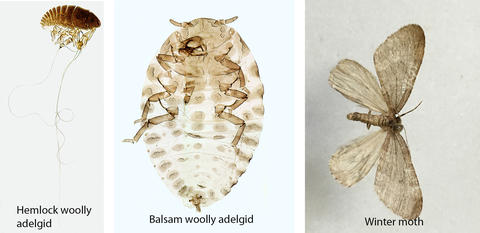
Non-native invasive pests are devastating forest ecosystems around the World. Preventing the introduction of non-native pests is immensely challenging given the enormous volume of intercontinental trade, and finding ways to manage them after they have become established is a race against time before they cause irreversible damage. We are providing information about the evolutionary history of multiple invasive forest pests and their natural enemies to better understand how to mitigate their impacts.
We are studying phylogenetics and population genetics of many of the major invasive forest pests in North America, including:
•The hemlock woolly adelgid, Adelges tsugae (Adelgidae), which originated in Japan and causes the death and decline of eastern North American hemlock trees.
•The balsam woolly adelgid, Adelges piceae (Adelgidae), which originated in Europe and has been killing fir trees throughout North America for over 100 years.
•The gypsy moth, Lymantria dispar (Lymantriidae), which was introduced from Europe over 100 years ago kills oaks and other tree species.
•The winter moth, Operophtera brumata (Geometridae), introduced from Europe which defoliates a broad range of tree species, including oaks and birches in southern New England.
This work is a collaboration with Nathan Havill (USDA Forest Service).
https://www.nrs.fs.fed.us/people/nphavill
Publications: Havill, N. P., S. D. Gaimari, and A. Caccone. 2018. Cryptic east-west divergence and molecular diagnostics for two species of silver flies (Diptera: Chamaemyiidae: Leucopis) from North America being evaluated for biological control of hemlock woolly adelgid. Biological Control. 121: 23–29.
Andersen, J. C., N. P. Havill, A. Caccone, and J. S. Elkinton. 2017. Postglacial recolonization shaped the genetic diversity of the winter moth (Operophtera brumata) in Europe. Ecology and Evolution. 7: 3312–3323.
Havill, N. P., J. Elkinton, J. C. Andersen, S. B. Hagen, H. J. Broadley, G. J. Boettner, and A. Caccone. 2016. Asymmetric hybridization between non-native winter moth, Operophtera brumata (Lepidoptera: Geometridae), and native Bruce spanworm, Operophtera bruceata, in the Northeastern United States, assessed with novel microsatellites and SNPs. Bulletin of Entomological Research. 107: 241–250.
Havill, N. P., S. Shiyake, A. Lamb Galloway, R. G. Foottit, G. Yu, A. Paradis, J. Elkinton, M. E. Montgomery, M. Sano, and A. Caccone. 2016. Ancient and modern colonization of North America by hemlock woolly adelgid, Adelges tsugae (Hemiptera: Adelgidae), an invasive insect from East Asia. Molecular Ecology. 25: 2065–2080.
Havill, N. P., G. Davis, D. L. Mausel, J. Klein, R. McDonald, C. Jones, M. Fischer, S. Salom, and A. Caccone. 2012. Hybridization between a native and introduced predator of Adelgidae: An unintended result of classical biological control. Biol Control. 63: 359–369.
Gaimari, S., N. Havill, J. Klein, and A. Caccone. 2010. Phylogeny of the adelgid-feeding Leucopini (Diptera: Chamaemyiidae): developing tools to inform adelgid biological control. In Onken, B., Reardon, R. (eds.), Proceedings of the Fifth Symposium on Hemlock Woolly Adelgid in the Eastern United States. Morgantown, West Virginia.
Havill, N. P., G. Davis, J. Klein, A. Caccone, and S. Salom. 2010. Hemlock woolly adelgid biological control: molecular methods to distinguish Laricobius nigrinus, L. rubidus, and their hybrids. In Onken, B., Reardon, R. (eds.), Proceedings of the Fifth Symposium on Hemlock Woolly Adelgid in the Eastern United States. Morgantown, West Virginia.
Davis, G. A., N. P. Havill, Z. N. Adelman, A. Caccone, L. T. Kok, and S. M. Salom. 2011. DNA barcodes and molecular diagnostics to distinguish an introduced and native Laricobius (Coleoptera: Derodontidae) species in eastern North America. Biological Control. 58: 53–59.
Havill, N. P., M. E. Montgomery, G. Yu, S. Shiyake, and A. Caccone. 2006. Mitochondrial DNA from hemlock woolly adelgid (Hemiptera: Adelgidae) suggests cryptic speciation and pinpoints the source of the introduction to eastern North America. Ann. Entomol. Soc. Am. 99: 195–203.
